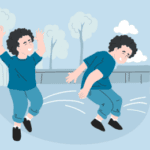
Blog
Exploring the Benefits of Sensory Diets
Author: DrSensory
October 18, 2024
Exploring the Benefits of Sensory Diets
Sensory diets are systematic and individualized strategies that help modify or meet sensory needs, particularly benefiting children and adults with various sensory challenges. Let’s delve into how sensory diets are tailored for specific conditions and why they hold such significance.

Sensory Diets for Children with Sensory Processing Disorder (SPD)
Children with Sensory Processing Disorder often experience difficulty in processing sensory information, which can lead to challenges in their daily lives. A sensory diet can provide these children with a structured plan of sensory activities tailored to meet their needs. Such activities might include using a weighted vest to promote calming sensory input, engaging in swinging to balance stimulation, or introducing tactile activities to fine-tune sensitivity levels. By implementing these sensory activities into their daily routine, children with SPD can achieve a more balanced sensory input, enhancing their focus, emotional regulation, and overall comfort.
Sensory Diets for Individuals with Autism Spectrum Disorder (ASD)
For individuals on the autism spectrum, sensory diets hold therapeutic potential by addressing either hypersensitivity or hyposensitivity to stimuli. These individuals often face significant sensory challenges, making it difficult for them to process sensations like sound, light, touch, or smell. Sensory diets can involve activities such as brushing protocols, sensory bins, or controlled auditory input, allowing individuals with ASD to engage with sensory processing in a manner that lessens distress and encourages engagement with their environment. This tailored approach can help ease anxiety, promote adaptability, and foster better interaction with the world around them.
Sensory Diets for Children with Attention Deficit Hyperactivity Disorder (ADHD)
Sensory diets also support children with ADHD in managing their energy and enhancing focus. These children often struggle with channeling their energy effectively throughout the day. Incorporating activities like jumping on a trampoline, using resistance bands, or squeezing stress balls can help them expel excess energy in a structured way. These types of activities can facilitate improved concentration and readiness to learn, positively affecting both their academic and social interactions.
Sensory Diets for Individuals with Anxiety Disorders
Anxiety can be overwhelming, leading to physical and emotional discomfort. Sensory diets can provide the calming and organizing input necessary to alleviate these symptoms. Techniques might include deep-breathing exercises, the use of a calming jar, or grounding techniques involving texture exploration. By integrating these sensory strategies, individuals can find relief from anxiety symptoms, restoring a sense of calm and reducing overall stress levels.
Sensory Diets for Anyone Experiencing Sensory Challenges
Sensory processing difficulties aren’t confined to specific conditions; they can affect anyone at any stage. A sensory diet can be tailored to assist anyone struggling with sensory processing issues in achieving regulation. By identifying which senses need modulation, whether it’s through tactile, proprioceptive, or vestibular exercises, individuals can gain greater control over their environment and improve their quality of life.
Sensory Diets for Elderly Individuals with Dementia
For elderly individuals, particularly those experiencing dementia, sensory diets can manage sensitivities and enhance life quality. Sensory activities such as aroma therapy, calming music, or soft tactile stimulation can provide soothing experiences. These strategies can contribute to emotional well-being, help maintain engagement, and foster a peaceful environment crucial for their daily living comfort.
Sensory Diets for People Recovering from Trauma or Brain Injury
In rehabilitation contexts, sensory diets play a vital role in supporting brain injury recovery. By providing structured and targeted sensory input, individuals undergoing rehabilitation can benefit from neuroplasticity, where the brain is encouraged to reorganize and adapt. Activities may include balance exercises, tactile stimulation, or controlled exposure to varied sensory inputs to support recovery.

What Are Sensory Diets?
A sensory diet is a tailored and purposeful selection of sensory activities aimed at meeting the unique sensory needs of an individual. Coined by occupational therapist Patricia Wilbarger, the term “sensory diet” draws an analogy to food nutrition, emphasizing the importance of providing the right balance of sensory inputs to achieve sensory wellness. These diets are carefully curated plans designed to regulate sensory input, helping individuals process sensory information effectively, and are usually developed with the guidance of an occupational therapist. By balancing types of senses engaged—such as auditory, tactile, or proprioceptive—a sensory diet acts as a strategy for obtaining optimal arousal levels, enhancing focus, and promoting emotional well-being.
How Are Sensory Diets Developed?
Sensory diets are developed through close collaboration between an individual, sometimes their family members, and an occupational therapist. The process begins with a comprehensive assessment to identify sensory challenges or preferences, informing the selection of activities. It’s crucial to consider the person’s daily routine, preferences, and specific sensory thresholds to devise an effective plan. The aim is to create a balanced regimen that seamlessly integrates into daily life, making sensory input not just beneficial but also enjoyable. Regular evaluations are required to ensure the sensory diet remains relevant and effective, with modifications introduced as needed.
Are Sensory Diets Only for Children?
While sensory diets are often associated with children, particularly those with developmental disorders like SPD, ASD, or ADHD, they are applicable to individuals of all ages. Adults and elderly individuals can equally benefit from sensory diets, addressing sensory processing challenges related to stress, anxiety, brain injuries, or even age-related sensory changes. The core principle of tailoring activities to meet individual sensory needs transcends age and condition, offering support and enhanced functioning across the lifespan.

What Are the Benefits of Implementing a Sensory Diet?
Implementing a sensory diet can yield numerous benefits, including improved focus, better emotional regulation, and diminished stress levels. For children, this could translate to heightened learning capabilities and social integration, while adults may find enhanced productivity and life satisfaction. Sensory diets also assist in diminishing the discomforts associated with sensory overload or sensory deprivation, allowing for a more balanced and engaging interaction with the external environment.
How Can Sensory Activities Integrate into Daily Routines?
Integrating sensory activities into daily routines involves seamlessly incorporating them into moments that naturally occur throughout the day. For example, activities like brushing teeth can become a tactile experience, while a routine walk can provide vestibular input. Simple adaptations such as the use of calming scents during relaxation or structured physical activities during breaks can serve essential sensory functions. The key is consistency and adaptability, ensuring that activities are both practical and sustainable within everyday life.
Who Can Help in Developing a Sensory Diet?
Occupational therapists specializing in sensory integration are ideally suited to develop and implement sensory diets. Their expertise in assessing sensory profiles and devising effective strategies makes them invaluable partners. Additionally, caregivers, educators, and even family members can be instrumental in observing needs and aiding the practical application of sensory activities in real-world settings, contributing to the success of a personalized sensory diet plan.
related blogs
Your child is constantly moving, crashing into furniture, or having meltdowns in response to seemingly minor things like a loud
Your toddler refuses to wear certain clothes, has huge meltdowns in noisy places, or is an extremely picky eater, limited
Your child seems to miss verbal instructions, struggles to follow conversations in noisy environments, and often asks "what?" even when
On the surface, autism and Ehlers-Danlos syndrome (EDS) might seem like two entirely unrelated conditions. One is a neurodevelopmental condition
The intense head pain begins, lights feel blindingly bright, and every sound seems amplified to an unbearable level. You retreat












































































